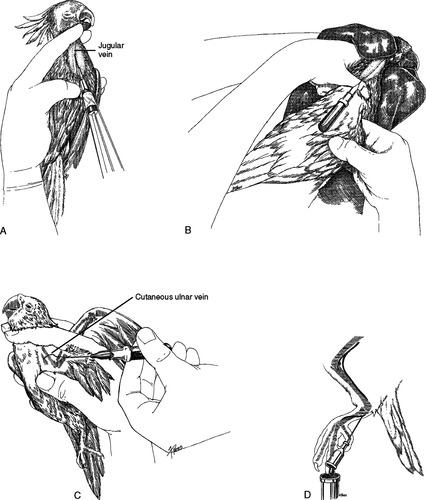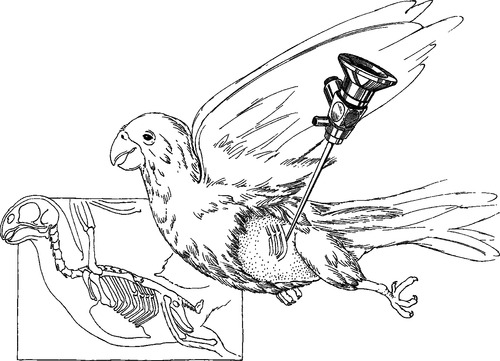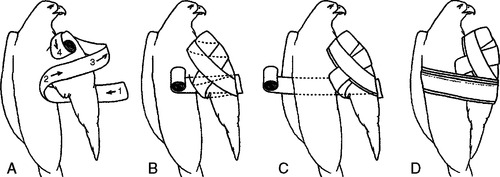CHAPTER 54. Pet Birds
Nickol P. Finch
TYPES OF BIRDS
I. Ratites: Ostriches, emus, and rheas
II. Anseriformes: Ducks, geese, and swans
III. Falconiformes: Eagles, hawks, and falcons (meat-eaters)
IV. Galliformes: Chickens, turkeys, pheasant, and quail
V. Columbiformes: Pigeons and doves (produce crop milk)
VI. Psittaciformes
A. Parrots
1. Have a hooked maxilla and zygodactyl feet (two toes go forward and two back)
2. Most are sexually monomorphic (cannot tell male from female by physical appearance)
B. Loriidae: Lories and lorikeets (eat nectar)
C. Cacatuidae: Cockatoos (have an erectile crest on the head)
D. Psittacidae: Parrots and parakeets
VII. Strigiformes: Owls
VIII. Piciformes: Toucans
IX. Passeriformes: Song birds, finches, and ravens
For most of the remainder of this section, we refer to birds of the psittacine family unless otherwise noted.
ORIGIN
I. New World: Birds from South and Central America (e.g., Amazons, macaws)
II. Old World: Birds from Africa and Asia (African grays, Eclectus, lovebirds, and cockatoos)
HUSBANDRY
I. Caging
A. Cage when not supervised; limits access to toxins, other pets, and possible dangers
B. Bird should be able to flap without touching anything; provide horizontal space for flight for smaller birds
C. Bar spacing should not allow escape or allow animal to get head caught between bars. Bars must be strong enough not to be bent by chewing. Homemade wire cages are often high in zinc, and most solders are high in lead
D. Perches: Sandpaper perches result in foot sores
E. Cage placement: Keep away from drafts, air vents, kitchen, and similar situations
II. Diet: Malnutrition is common in diets with mixtures of seeds, pellets, and human foods
A. Seeds
1. High in fat and usually high in vitamin E, but high fat content increases vitamin E requirements. Leads to obesity, fatty liver disease, egg binding
2. Low in vitamin A, calcium, multiple B vitamins, iron, copper, and selenium
3. Fortified seed diets apply supplement to seed hulls. Because seeds are hulled, birds consume little of the supplement
B. Pellets
1. Best choice for feeding usually. Switching to pelleted diets can be very difficult
2. Colored pellets can change the color of feces; be aware of color preferences in birds
C. Human foods: Consumption can lead to deficiencies or excesses similar to seed diets
D. Supplements: Many are added to water, changing the taste, resulting in decreased water intake
III. Environmental considerations
A. Smokers in the household, other birds or pets, presence of air fresheners or candles
B. Cleaning practices, such as cage cleaning, food and water changing, examination of toys for damage
CLINICAL CONSIDERATIONS
I. Hands-off examination
A. Observe from a distance first
B. Evaluate behavior (perching, sitting on bottom of cage, tail bob, regurgitation, sleeping during the day)
D. Evaluate eyes, nares, beak, feathers, attitude, posture, and feces without restraint
E. Determine whether the animal can handle the stress of restraint. The bird may need to be placed in oxygen or needs other supportive measures before restraint
II. Capture and restraint
A. Use a towel for protection and to control wings
B. Leather gloves are not generally considered appropriate for psittacines patients
C. Catch the bird around the neck with the thumb in the intermandibular space and the fingers around the neck. For large birds, the second hand helps control the wings and wraps the towel around the body
D. Make the room completely dark to facilitate capture
E. Aggressive birds are best caught from a cat carrier turned on end
III. Hands-on examination
A. Start from the head and work back. Evaluate eyes, nares, cere (the fleshy part that the nostrils are located in), feathers, lore (featherless area surrounding eye in some birds), and beak condition and shape
B. Palpate wings and legs for fractures. Look at underside of wings for evidence of feather picking or chewing and examine for blood feathers (newly growing feathers). Check toenails and feet for length and injuries
C. Palpate pectoral muscle for adequacy. If you cannot feel the keel through the overlying tissues, the animal is likely too fat. Differences between sides may indicate disuse or neurogenic atrophy
D. Palpate abdomen. May feel ventriculus, which is hard and round. Hard, immobile structure may be an egg
E. Evaluate sinuses, heart, lungs, and airsacs
F. Can use a tongue depressor or speculum to open mouth
IV. Diagnostics
A. Fecal examination
1. Remember that colored foods can change the color of a bird’s feces
2. Psittacines typically possess 70% or more gram-positive bacteria, with a mixed colony of rods and cocci. Clostridia is not normal in psittacines’ feces
3. Yeast in the feces is a common finding in birds that eat bread products
B. Blood collection (Figure 54-1)
 |
| Figure 54-1 Venipuncture sites: A, Jugular vein, birds weighing less than 200 g. B, Jugular vein, larger birds. C, Cutaneous ulnar vein. D, Caudal tibial vein. (From Birchard SJ, Sherding RG. Saunders Manual of Small Animal Practice, 3rd ed. St Louis, 2006, Saunders.) |
1. Nail clipping is not appropriate; samples are contaminated with feces or lymph, and it is painful
2. Jugular vein: Usually exists in a featherless patch along the neck; right jugular is usually larger than the left but not always. Do not have to hold the vessel off; blood pressure is usually high enough to allow drawing without (except in very sick birds)
3. Cutaneous ulnar (also known as basilic or brachial vein). Located at bend of elbow
4. Medial metatarsal vein: Located on the inside of leg between tarsus and stifle. Usually have to hold the area off for a relatively long time
C. Hematology and chemistry
1. Complete blood cell count
a. Packed cell volume (PCV): Essentially the same as PCV in mammals
b. Heterophils: Equivalent of neutrophils in mammals. Increase with inflammation and infection; stress heterophilia is common
c. Lymphocytes: Some birds normally have more lymphocytes than heterophils. True lymphocytosis occurs with chlamydophila or viral disease
d. Monocytes: Monocytosis is common in chronic infection
e. Eosinophils: May be increased with parasitism or tissue damage
f. Basophils: Can be confused with toxic heterophils. Basophilia may occur in respiratory disease, resolving tissue damage, or chlamydophila infection
2. Lactic dehydrogenase: Not liver specific; from muscle or liver
3. Aspartate aminotransferase (AST): Liver, skeletal muscle, or cardiac muscle in origin. Low AST seen in advanced hepatocellular damage with fibrous replacement
4. Alanine aminotransferase: Not useful in birds due to low activity
5. Creatine kinase: From skeletal muscle, cardiac muscle, and nerve tissue
6. Alkaline phosphatase: Elevated in bone disorders; not useful in liver disease
7. γ-glutamyltransferase: Not sensitive for liver damage in birds
8. Amylase and lipase: Not considered useful in birds at this time
9. Uric acid: Elevated with renal disease or dehydration
10. Creatinine: Not useful for renal disease. Elevated when feeding high-protein diets (often elevated in raptors)
11. Urea: Not helpful in birds
12. Calcium: Increased during egg production; decreased secondary to seed-based diets. African gray parrots are predisposed to low calcium
13. Phosphorus: Renal disease is often not clinical until bird is very near death so increased phosphorus is not often appreciated
14. Glucose: Hyperglycemia with stress, renal disease, diabetes mellitus. Hypoglycemia with starvation
15. Cholesterol: High-fat diets may lead to high cholesterol; atherosclerosis may occur in birds. Most birds have fasting bile acids of less than 100 μmol/L
16. Sodium: Increased with increased salt intake, dehydration, or salt poisoning
17. Potassium: Increased with renal disease, severe tissue damage, or dehydration
D. Radiographs
1. Chemical restraint is often necessary
2. Lightly applied masking tape is often used to facilitate positioning; remove tape by pulling with the feather growth. Make sure movement of chest (respiration) is not restricted
3. Normal anatomy
a. Long bones normally have relatively thin cortices
b. Trachea seen on right side of neck, and the lungs normally have a honeycomb appearance
c. Do not mistake the great vessels for granulomas
d. Crop may have food in it and is located just cranial to thoracic inlet
e. Ventriculus lies in caudal abdomen behind the liver
f. Kidneys are difficult to evaluate on radiographs
g. Reproductive organs change dramatically in size, depending on reproductive activity. When active, testes or female tract can be mistaken for abdominal mass. Testes and ovaries are located at the cranial pole of the kidneys
F. Ceolomic endoscopy: Uses the air sacs to allow visualization of organs (Figure 54-2)
 |
| Figure 54-2 Preparation for endoscopy of the abdominal air sac; inset, trocar or cannula site. (From Birchard SJ, Sherding RG. Saunders Manual of Small Animal Practice, 3rd ed. St Louis, 2006, Saunders.) |
V. Clinical techniques
A. Fluid therapy
1. Maintenance rate 50 mL/kg daily is used in most adult birds
2. Given subcutaneously (SC), intravenously (IV), intraosseous (IO), or orally (PO)
a. IV fluids given in jugular vein, cutaneous ulnar vein, or tarsal vein
b. IO is given in the ulna or tiba
c. Do not give more than 1 mL/30 g body weight. Use gavage tube
B. Medication administration
1. Intramuscular (IM) injections
a. Pectoral muscles: Most common site for IM injections, but do not use in racing pigeons or working falcons as irritation or pain to the pectoral muscle can greatly decrease flyability
b. Gastrocnemius muscles
(1) Smaller muscle that can be more difficult to isolate
(2) May result in temporary pain and reluctance to stand
2. IV injections can be given in locations listed for blood collection
3. PO administration: Unless the medication is something that tastes good, use a gavage tube to avoid potential aspiration
4. Nebulization: Good way to get drugs into the respiratory tract
C. Bandage and splint application
1. Figure-8 bandage (Figure 54-3) is used to immobilize anything from the elbow distally, including the radius, ulna, carpus, metacarpals, and phalanges. If the shoulder or humerus is affected, add a bodywrap to stabilize affected areas
 |
| Figure 54-3 The figure-of-eight bandage is one of the most common and useful bandages placed on avian patients. (From Mitchell MA, Tully TN. Manual of Exotic Pet Practice, St Louis, 2009, Saunders.) |
2. Robert Jones bandage
a. Good for supporting damaged tissues. Thermoplastic materials can be used to make the bandage suitable for fracture stabilization
b. Assure that the bandage is not too tight
3. Tape splint
a. May be suitable as only coaptive device for leg fractures in small birds (less than 100 g)
b. Used successfully in birds of 500 g if additional support is added
c. In birds less than 50 g this is usually enough to immobilize the fracture
d. Actively growing birds may have clinical union of fractures within 2 to 3 weeks. Will have to change or modify bandages for these birds often as they outgrow them very quickly (sometimes as often as twice per week)
VI. Anesthesia
A. Recommended fasting times
1. Birds weighing less than 100 g are fasted for approximately 1 to 2 hours
2. Birds weighing 300 g are fasted for 3 to 4 hours
3. Birds weighing 600 g or more are fasted for 6 hours
B. Avoid cuffed endotracheal tubes. Birds have complete tracheal rings in their tracheas, which can result in tracheal necrosis if the cuff is inflated
C. Monitor anesthetic depth by response to painful stimuli, muscle tone, palpebral reflex, and respiratory rate and depth
D. Inhalant
1. Mask induction. Be careful that the bird does not eat the mask during inducing
2. Monitor closely. Any decrease in respiratory rate once the animal is asleep and “stable” necessitates an immediate decrease in anesthetic concentration
3. Benefits include being able to turn off quickly, having control over respiration, and the ability to administer oxygen
4. Isoflurane and sevoflurane are inhalants of choice. Halothane has been used, but isoflurane is faster and safer
5. Use a nonrebreathing system for birds under 10 kg
E. Injectable
1. Used more commonly in ratites
2. Benefits: Minimizes handling time and consequently risk to handler
3. Aspiration can be a problem when bird is sedated but cannot keep head up; will still fight restraint
VII. Drugs: Beyond the scope of this discussion to cover everything
A. Do not use steroid preparations in birds except under dire circumstances of head trauma or shock
B. In pet birds, exercise caution when using drugs with a gram-positive spectrum because most of a psittacine bird’s normal gut flora is composed of gram-positive organisms
C. Budgies: May have increased sensitivity to ivermectin
ORGAN SYSTEMS
I. Dermatology
A. Anatomy of skin: Much thinner than in mammals
1. Dermis contains feathers
2. Bill or beak (rhampotheca): Contains Herbst corpuscles (mechanoreceptors used for food discrimination)
3. Nails surround distal phalanx as in mammals
4. Most birds have an uropygial gland (preen gland) found at the base of the tail, which has a purpose in waterproofing the feathers. Can become abscessed or develop neoplasia and require removal
B. Feather formation, anatomy
1. Contour feathers
a. Primary flight feathers insert dorsally on the carpus and distally
b. Secondary flight feathers insert along the ulna
c. Tail feathers insert on the pogostyle
2. Semiplume feathers: Fluffy feathers that enhance thermal insulation
3. Filoplume feathers are associated with a Herbst corpuscle and are involved in providing sensory information
4. Bristle feathers are found at base of eyelids, nares, and mouth and are involved in providing sensory information
5. Down feathers contribute at least in part to maintaining body temperature
6. Powder down feathers shed a powdery keratin, which assists in cleaning. Large numbers of these feathers account for the powder seen with cockatoos and African gray parrots
C. Loss and replacement of feathers is referred to as molt. Growing feathers are called blood feathers
D. Common problems
1. Broken blood feathers
a. Easiest way to stop a bleeding blood feather is to pluck the feather. The clot can then adhere to the skin of the feather follicle, and hemostasis occurs normally. When a new feather grows, some birds are prone to repetitive injuries of the same feather(s). Owners will often report that they think the bird has a broken wing
b. There is usually a large amount of blood, and birds can suffer considerable blood loss, leading to hypovolemia and shock
2. Feather picking or feather-destructive behaviors: Alteration of behavior with drugs or restraint devices may be necessary. Causes include the following:
a. Behavioral (e.g., obsessive compulsive disorders, boredom). Diagnosis of exclusion, rule out all other possible causes of feather picking first
b. Pain response from newly growing feathers or feather cysts
c. Aggression from other birds. Common during the breeding season and in finches
d. Poor skin condition: Lack of essential fatty acids in diet or environmental conditions (lack of humidity, etc.)
e. Skin infections (bacterial, fungal)
f. Hypersensitivity (very difficult to diagnose)
g. Parasites: Mites (common in psittacines) or lice (rare in psittacines)
h. Psittacine beak and feather diseas: See infectious section below
3. Feather cysts
a. Most common in canaries and often seen on wings. May see the feather curled around in the cyst. May be mistaken for fibrosarcoma or xanthoma
b. Can make a small incision and remove the feather material. Then cauterize the base of the follicle with silver nitrate. Alternatively, can surgically remove the offending feather follicle
4. Psittacine beak and feather disease: See infectious section below
5. Bumblefoot: Pododermatitis
a. Most commonly seen in captive raptors and overweight, sedentary psittacines
b. Staphylococcus species most frequently identified
c. Treat the infection and change lifestyle (e.g., weight loss)
6. Neoplasia
a. Lymphosarcoma most commonly reported
b. Xanthoma is a benign neoplasia seen commonly in budgerigars and cockatiels. Often require removal
c. Fibrosarcoma
d. Squamous cell carcinoma: Often in Amazons, though has also been seen in budgies and cockatiels
II. Skeletal system
A. Anatomy and physiology. Light bones with relatively thin cortices in flighted birds
1. Axial skeleton
a. Most of the vertebral bodies (except in the cervical region) are fused
b. Synsacrum is a fusion of the caudal thoracic, lumbar, sacral, and caudal vertebrae and is fused to the ilium
Stay updated, free articles. Join our Telegram channel

Full access? Get Clinical Tree


